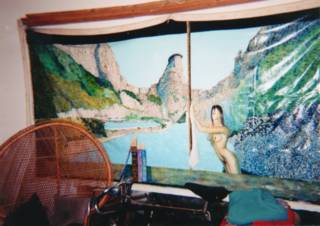
'Canopy'
 one of the funs in doing still lifes is the opportunity to play with a few oddball notions - such as the query of what is or is not seen within or without, as presented here..... the themetitle is an obvious one, yet just what is canopied remains the query- IS this an empty bottle, from which is seen a shore view, ir is it all within the bottle, cleverly arranged on the ledge so as to be presumed a part of the background... as another of the whimsical pieces of long ago (and, sadly, destroyed in a fire), there was always a delight in how the bottle so well played against the rest of the piece, and at the same time raise some strong philosophical intimations..... yes - that is right, philosophical intimations..... why? because of the determination of it being a work of visual art - remember, there is a universe within the borders of this, so it behoves asking the pertinant questions regarding just what kind of universe is seen here, including the oft overlooked one of just where 'man' is in here and what is the place of 'man' in here, what is the relationship in here of the presence, is it positive or negative, deliberate or happenstance, future oriented or past, productive or otherwise, or is there any real significance to it at all - and why or why not..... there is even reason to ask if it would have been improve by colorful fruits being incorporated into the work - perhaps at least orangeness if not reds here and there - AND of what significance metaphorically any of this would have, assuming there would even be any significance....
one of the funs in doing still lifes is the opportunity to play with a few oddball notions - such as the query of what is or is not seen within or without, as presented here..... the themetitle is an obvious one, yet just what is canopied remains the query- IS this an empty bottle, from which is seen a shore view, ir is it all within the bottle, cleverly arranged on the ledge so as to be presumed a part of the background... as another of the whimsical pieces of long ago (and, sadly, destroyed in a fire), there was always a delight in how the bottle so well played against the rest of the piece, and at the same time raise some strong philosophical intimations..... yes - that is right, philosophical intimations..... why? because of the determination of it being a work of visual art - remember, there is a universe within the borders of this, so it behoves asking the pertinant questions regarding just what kind of universe is seen here, including the oft overlooked one of just where 'man' is in here and what is the place of 'man' in here, what is the relationship in here of the presence, is it positive or negative, deliberate or happenstance, future oriented or past, productive or otherwise, or is there any real significance to it at all - and why or why not..... there is even reason to ask if it would have been improve by colorful fruits being incorporated into the work - perhaps at least orangeness if not reds here and there - AND of what significance metaphorically any of this would have, assuming there would even be any significance....


















